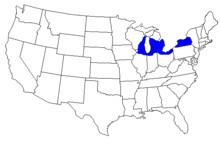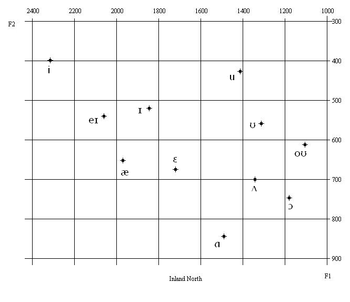- Inland Northern American English
-
 This map shows the approximate extent of the Northern Cities Vowel Shift, and thus the approximate area where the Inland North dialect predominates. Note that the region surrounding Erie, Pennsylvania, is excluded; the dialect spoken there more closely resembles that of Pittsburgh.
This map shows the approximate extent of the Northern Cities Vowel Shift, and thus the approximate area where the Inland North dialect predominates. Note that the region surrounding Erie, Pennsylvania, is excluded; the dialect spoken there more closely resembles that of Pittsburgh.
The Inland North dialect of American English is spoken in a region that includes most of the cities along the Erie Canal and on the U.S. side of Great Lakes region, reaching approximately from Utica, New York to Green Bay, Wisconsin, as well as a corridor extending down across central Illinois from Chicago to St. Louis.[1]
This dialect used to be the Standard Midwestern speech that is traditionally regarded as the basis for General American in the mid-20th century,[2] though it has been since modified by an innovative vowel shift known as the Northern Cities Shift, which has altered its character.[3]
Notable speakers of the Inland North Dialect include US President Ronald Reagan, former Governor of Massachusetts Mitt Romney, actors, Dennis Farina, Dennis Franz, Gene Wilder, as well as the late John Belushi and Chris Farley; US Secretary of State Hillary Clinton; actresses Bonnie Hunt and Jami Gertz; filmmaker Michael Moore; financial adviser Suze Orman; talk show host Steve Wilkos; and musicians Iggy Pop and Bob Seger.
The dialect was used for comedic affect in the Saturday Night Live skit Bill Swerski's Superfans, and in the film The Blues Brothers.
Contents
Distribution
The Inland North consists of western and central New York State (Syracuse, Rochester, Buffalo, Binghamton, Jamestown, Olean); northern Ohio (Akron, Cleveland, Toledo); Michigan's Lower Peninsula (Detroit, Flint, Grand Rapids, Lansing); northwestern Indiana (Gary); northern Illinois (Chicago, Rockford); and southeastern Wisconsin (Kenosha, Racine, Milwaukee).
A corridor of cities along Interstate 55 southwest of Chicago as far as St. Louis, Missouri, which historically belong to the Midland region, have also begun taking on features of the Inland North's Northern Cities Shift in recent decades. On the other hand, Erie, Pennsylvania was regarded as an Inland North city by researchers in the first half of the 20th century, but it never underwent the Northern Cities Shift and now shares many features with the rest of Western Pennsylvania.
Many African-Americans in Detroit are multidialectal and also or exclusively use AAVE, but some do use this dialect, as do almost all people of non-African descent in and around the city.
Characteristics
Phonology
Many of the characteristics listed here are not unique to the region, but are found elsewhere in the United States, especially elsewhere in the Midwest.
- As in General American, Inland North speech is rhotic.
- The Mary–marry–merry merger: Words containing /æ/, /ɛ/, or /eɪ/ before an r and a vowel are all pronounced "[ɛ~eɪ]-r-vowel", so that Mary, marry, and merry all sound the same as each other, and have the same first vowel as Sharon, Sarah, and bearing. This merger is widespread throughout the Midwest, West, and Canada.
- The Inland North does not undergo the cot–caught merger.
- Many speakers in the region rhyme the word on with don, not with dawn.[4]
Phonetics
- The Northern cities shift
Main article: Northern cities vowel shiftThis chain shift is found only in the Inland North—in fact, it is the feature that defines the Inland North, for modern dialectological purposes. It has been occurring in six stages:
- The first stage of the shift is the general raising and fronting of /æ/, which often comes to be realized as a centering diphthong of the type [eə] or [ɪə].
- The second stage is the fronting of /ɑ/ to [a], which occupies a place close to the former /æ/.
- In the third stage, /ɔ/ lowers towards [ɑ].
- The fourth stage is the backing and lowering of /ɛ/.
- During the fifth stage, /ʌ/ is backed towards [ɔ].
- In the sixth stage, /ɪ/ is lowered and backed, although it is kept distinct from /ɛ/ in all phonetic environments, so the pin–pen merger does not occur.
Note that this shift is in progress across the region, but that each subsequent stage is a result of the previous one(s), so that an individual speaker may not display all of these shifts, but no speaker will display the last without also showing the ones before it.
- Other characteristics
- Canadian raising of /aɪ/, though usually not of /aʊ/, is found in this region.[5] It occurs before some voiced consonants. For example, many speakers pronounce fire, tiger, and spider with the raised vowel.
- When it is not subject to raising, the nucleus of /aɪ/ is pronounced with the tongue further to the front of the mouth than that of /aʊ/. Relatedly, the nucleus of /aɪ/ may be more fronted than it is in some other North American accents and the nucleus of /aʊ/ may be more backed than in some other North American accents.
- Like /aʊ/, the nucleus of /oʊ/ (as in go and boat) remains a back vowel [oʊ], not undergoing the fronting that is common in some other regions. Similarly, the traditionally high back vowel /uː/ tends to be less fronted in the North than in other regions, though it still undergoes some fronting especially after coronal consonants.[6]
- /ɑr/ (as in bar) is fronted for many speakers in this region, resulting in variants like [bäɹ] or even [baɹ].
Vocabulary
Note that not all of these are specific to the region.
- Faucet vs. Southern spigot.
- (Peach) Pit vs. Southern stone or seed.
- Pop for soft drink, vs. East-Coastal and Californian soda and Southern coke. The "soda/pop line" has been found to run between Western and Central New York State (Buffalo residents say "pop" while Syracuse residents who used to say "pop" until sometime in the 1970s now say "soda." Lollipops are also known as "suckers" in this region.) In parts of eastern Wisconsin and in a huge area centered around St. Louis, soda is more common.
- Shopping cart vs. Southern buggy.
- Teeter totter vs. Southern seesaw.
- Tennis shoes' or 'gym shoes' vs. New England sneakers.
- Drinking fountain vs. Water fountain vs Bubbler.
Individual cities and regions also have their own vocabularies. For example:
- in eastern and southern Wisconsin, drinking fountains are known as bubblers
- in the Chicago area, sneakers are often known as gym shoes
- in Michigan, convenience stores are called party stores
- in Detroit, sliding glass doors may be called doorwalls
- Buffalo, Rochester, Syracuse, Utica, and Binghamton residents say "sneakers" rather than "tennis shoes"
- in Cleveland the road verge (grass between the sidewalk and the street) is called a tree lawn, whereas in nearby Akron the same space is called a devilstrip.
- Automated Teller Machines (ATM) are called Take Your Money Everywhere (TYME) throughout most of Wisconsin, resulting in locals asking, "Where's the nearest Tyme machine?" Used outside of this area people will think they are being asked directions to a time machine.
See also
- List of dialects of the English language
- American English regional differences
- North Central American English
- Northern cities vowel shift
References
Sources
- Labov, William, Sharon Ash, and Charles Boberg (2006). The Atlas of North American English. Berlin: Mouton de Gruyter. ISBN 3-11-016746-8
External links
- Chicago Dialect Samples
- The Guide to Buffalo English
- Nick Digilio Interview with Corrine McCarthy About Chicago Accent
- The Northern Cities Vowel Shift
- NPR interview with Professor William Labov about the shift
- PBS resource from the show "Do you Speak American?"
- Select Annotated Bibliography On the Speech of Buffalo, NY
- Telsur Project Maps
Categories:- American English
- Culture of Buffalo, New York
- Culture of Chicago, Illinois
- Culture of Cleveland, Ohio
- Culture of Detroit, Michigan
- Culture of Milwaukee, Wisconsin
- Culture of Rochester, New York
- Culture of Syracuse, New York
- Illinois culture
- Indiana culture
- Michigan culture
- New York culture
- Ohio culture
- Wisconsin culture
Wikimedia Foundation. 2010.

